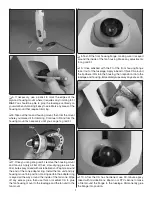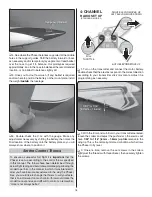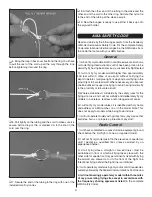
22
9) Under no circumstances may a pilot or other person touch
a powered model in fl ight;
nor should any part of the model
other than the landing gear, intentionally touch the ground,
except while landing.
CHECK LIST
During the last few moments of preparation your mind may
be elsewhere anticipating the excitement of the fi rst fl ight,
causing you to overlook certain checks and procedures.
Follow the check below to avoid this.
❏
1. Confi rm that all controls operate in the correct direction.
❏
2. Make certain you’ve set the
C.G.
and the
control throws
according to the measurements provided in the manual.
❏
3. Make sure the servo arms are secured with the screws
that came with them and make sure the set screws in the
collars on the pushrods are tightened with threadlocker.
❏
4. Make sure the elevon horns are secure and glued.
❏
5. Make sure the receiver antenna(s) are mounted per the
manufacturer’s instructions.
❏
6. Tug on the elevons to make sure all the hinges are
securely
glued in place.
❏
7. Place your name, address, AMA number and telephone
number on or inside your model.
❏
8. Range check your radio when you get to the fl ying fi eld.
FLYING
The Phazer is a great-fl ying model that fl ies smoothly and
predictably, but it possesses no self-correcting tendencies
what-so-ever and therefore, must be fl own only by reasonably-
experienced pilots who are able to decisively provide the
correct control inputs.
Ground Check and Range Check
Perform an operational ground check of your radio following
the manufacturer’s instructions that came with your radio.
Set a Flight Timer
Prevent over discharging your LiPos and/or dead-stick landings
by using the timer in your transmitter (or a separate timer if
your transmitter doesn’t have one) to signal when it’s time to
land. If your transmitter has a timer built in, link the timer to
the throttle stick so it starts and stops when the stick is raised
to about 10% – that way you’ll be counting actual motor run
time, not total air time.
Until you have the data to make your own calculations, set
your timer to a conservative 3-minutes so you won’t go over.
Here’s how to calculate your own fl ight times:
You need to know three things:
A.
The target capacity you want to use from your battery
for a fl ight.
B.
How long you fl ew.
C.
How much capacity was used from the battery for that
fl ight.
To prevent over discharging your battery you should use
no more than 80% of your battery’s capacity. If using the
recommended 2200mAh battery that would be 1760mAh
(2200mAh x .8).
Say for example, you fl ew for three minutes and it took 1275mAh
to recharge your battery. Since your limit is 1760mAh you still
had 485mAh to go, so lengthen your fl ight time accordingly. You
could also calculate that the consumption rate for that fl ight
was 425mAh per minute (1275mAh divided by 3 minutes).
Dividing your target capacity of 1760mAh/minute by 425mAh/
minute gives you a fl ight time of 4.1 minutes (4 min. 6 seconds—
virtually 4 minutes.)
Do this for several trials (or for every fl ight!) to calculate
accurate values for how long you can fl y!
Launching
Don't forget to install the 3mm battery plate screw with
threadlocker. This needs to be done only once every dozen
or so fl ights as residual threadlocker suffi ciently holds the
screw in place.
The Phazer may be hand-launched or bungee-launched by
an assistant or by the pilot. If you’re at all hesitant, the easiest
and surest way to get your Phazer airborne is to have an
assistant bungee launch it for you—at least for the maiden
fl ight. After that you can bungee-launch it yourself every time.
Experienced pilots who don’t feel like setting up the bungee
can defi nitely hand-launch the Phazer themselves, or have
an assistant hand-launch it for them. The bungee might be a
bit of a hassle to unwind, lay out and put away, but it’s a
no-
brainer
and
guaranteed
to get your Phazer in the air.
To bungee-launch the Phazer, be sure the ground will hold the
stake securely, then push it all the way in at about a 45 degree
angle away from the launch spot. Unwind the bungee, laying it
out so the launch will be into the wind. As the bungee unwinds,
always inspect the tubing and cord to make sure there are no
cuts, cracks, tears or any other defects. Also make sure the
line and cord are
securely
connected to the rings and stake.
After you have the bungee laid out, but before stretching it
out, turn on your transmitter and connect the battery. As you
should always do before every fl ight,
double-check that
the controls are responding properly and in the correct
direction
, then arm the motor and run it up for a second to
make sure it is making full power.



































